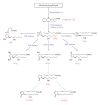Prostaglandins as PPARγ Modulators in Adipogenesis
- PMID: 23319937
- PMCID: PMC3540890
- DOI: 10.1155/2012/527607
Prostaglandins as PPARγ Modulators in Adipogenesis
Abstract
Adipocytes and fat cells play critical roles in the regulation of energy homeostasis. Adipogenesis (adipocyte differentiation) is regulated via a complex process including coordinated changes in hormone sensitivity and gene expression. PPARγ is a ligand-dependent transcription factor and important in adipogenesis, as it enhances the expression of numerous adipogenic and lipogenic genes in adipocytes. Prostaglandins (PGs), which are lipid mediators, are associated with the regulation of PPARγ function in adipocytes. Prostacyclin promotes the differentiation of adipocyte-precursor cells to adipose cells via activation of the expression of C/EBPβ and δ. These proteins are important transcription factors in the activation of the early phase of adipogenesis, and they activate the expression of PPARγ, which event precedes the maturation of adipocytes. PGE(2) and PGF(2α) strongly suppress the early phase of adipocyte differentiation by enhancing their own production via receptor-mediated elevation of the expression of cycloxygenase-2, and they also suppress the function of PPARγ. In contrast, PGD(2) and its non-enzymatic metabolite, Δ(12)-PGJ(2), activate the middle-late phase of adipocyte differentiation through both DP2 receptors and PPARγ. This paper focuses on potential roles of PGs as PPARγ modulators in adipogenesis and regulators of obesity.
Figures


Similar articles
-
Stable expression of lipocalin-type prostaglandin D synthase in cultured preadipocytes impairs adipogenesis program independently of endogenous prostanoids.Exp Cell Res. 2012 Feb 15;318(4):408-15. doi: 10.1016/j.yexcr.2011.11.003. Epub 2011 Nov 9. Exp Cell Res. 2012. PMID: 22100987
-
Mast cells function as an alternative modulator of adipogenesis through 15-deoxy-delta-12, 14-prostaglandin J2.Am J Physiol Cell Physiol. 2011 Dec;301(6):C1360-7. doi: 10.1152/ajpcell.00514.2010. Epub 2011 Aug 24. Am J Physiol Cell Physiol. 2011. PMID: 21865589
-
15-Deoxy-Δ(12,14)-prostaglandin J(2) interferes inducible synthesis of prostaglandins E(2) and F(2α) that suppress subsequent adipogenesis program in cultured preadipocytes.Prostaglandins Other Lipid Mediat. 2011 Aug;95(1-4):53-62. doi: 10.1016/j.prostaglandins.2011.06.002. Epub 2011 Jun 12. Prostaglandins Other Lipid Mediat. 2011. PMID: 21699992
-
The elusive endogenous adipogenic PPARγ agonists: Lining up the suspects.Prog Lipid Res. 2016 Jan;61:149-62. doi: 10.1016/j.plipres.2015.11.002. Epub 2015 Dec 15. Prog Lipid Res. 2016. PMID: 26703188 Review.
-
Prostaglandin D2 and F2α as Regulators of Adipogenesis and Obesity.Biol Pharm Bull. 2022;45(8):985-991. doi: 10.1248/bpb.b22-00210. Biol Pharm Bull. 2022. PMID: 35908908 Review.
Cited by
-
Adipocyte-derived PGE2 is required for intermittent fasting-induced Treg proliferation and improvement of insulin sensitivity.JCI Insight. 2022 Mar 8;7(5):e153755. doi: 10.1172/jci.insight.153755. JCI Insight. 2022. PMID: 35260536 Free PMC article.
-
Induction of peroxisome proliferator activated receptor γ (PPARγ) mediated gene expression and inhibition of induced nitric oxide production by Maerua subcordata (Gilg) DeWolf.BMC Complement Med Ther. 2020 Mar 12;20(1):80. doi: 10.1186/s12906-020-2856-2. BMC Complement Med Ther. 2020. PMID: 32164648 Free PMC article.
-
The effects of dietary linoleic acid and hydrophilic antioxidants on basal, peak, and sustained metabolism in flight-trained European starlings.Ecol Evol. 2020 Jan 18;10(3):1552-1566. doi: 10.1002/ece3.6010. eCollection 2020 Feb. Ecol Evol. 2020. PMID: 32076533 Free PMC article.
-
Epoxygenase inactivation exacerbates diet and aging-associated metabolic dysfunction resulting from impaired adipogenesis.Mol Metab. 2018 May;11:18-32. doi: 10.1016/j.molmet.2018.03.003. Epub 2018 Mar 9. Mol Metab. 2018. PMID: 29656108 Free PMC article.
-
PPARɣ drives IL-33-dependent ILC2 pro-tumoral functions.Nat Commun. 2021 May 5;12(1):2538. doi: 10.1038/s41467-021-22764-2. Nat Commun. 2021. PMID: 33953160 Free PMC article.
References
LinkOut - more resources
Full Text Sources
Miscellaneous

